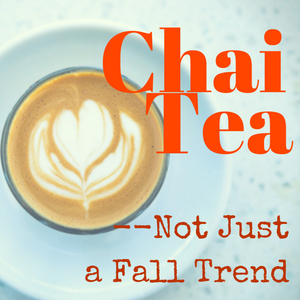
Before your local Starbucks, coffee shop, tea house, and even quiet local diner got in on the chai tea craze, it was already culturally important to the people of India.
 Chai tea, if you’ve managed to avoid it thus far, is a black tea (usually Ceylon), with any variety of spices added. While the mixture of spices can vary wildly, most chais keep to a pallet of cinnamon, cardamom, clove, and pepper. Some chais, such as our Vanilla Chai, also add sweeter flavor elements. In spite of their spices, chais should generally come across as savory and sweet, rather than spicey, because they are traditionally served with milk and sugar. While it’s less traditional, mixing in a bit of cocoa powder (or chocolate syrup, if that’s what you have around) doesn’t hurt.
Chai tea, if you’ve managed to avoid it thus far, is a black tea (usually Ceylon), with any variety of spices added. While the mixture of spices can vary wildly, most chais keep to a pallet of cinnamon, cardamom, clove, and pepper. Some chais, such as our Vanilla Chai, also add sweeter flavor elements. In spite of their spices, chais should generally come across as savory and sweet, rather than spicey, because they are traditionally served with milk and sugar. While it’s less traditional, mixing in a bit of cocoa powder (or chocolate syrup, if that’s what you have around) doesn’t hurt.
 Chai tea is served with milk because it is originally a British drink. When the British colonized India, largely because they could grow cotton and tea there, they brought their tea habits with them. This included the traditional British high tea with milk and sugar, which the wealthy elites of the new colony had to admit, was pretty nice.
Chai tea is served with milk because it is originally a British drink. When the British colonized India, largely because they could grow cotton and tea there, they brought their tea habits with them. This included the traditional British high tea with milk and sugar, which the wealthy elites of the new colony had to admit, was pretty nice.
The people of India eventually decided that British rule wasn’t something that they were fond of. There was a large and non-violent series of protests, mostly led by Gandi, whom you should remember from history class, and India did eventually win its independence.
 Now, India faced a major cultural problem. Well, technically, it faced two. One was a major religious divide between Hindus and Muslims which led to the partition of India into India, Pakistan, and Bangladesh. But the other was tea. There was pretty much nothing more British in 1947 than a good cup of Ceylon (which is odd, because it was grown in India*, but that’s colonization for you). The people of India definitely did not want to be drinking the drink of their oppressors. However, they also did not want to give up their tea. Therefore, India made their tea Indian, by loading it full of local spices. Thus, chai tea became a bit of a symbol of independence and national identity for the nation of India.
Now, India faced a major cultural problem. Well, technically, it faced two. One was a major religious divide between Hindus and Muslims which led to the partition of India into India, Pakistan, and Bangladesh. But the other was tea. There was pretty much nothing more British in 1947 than a good cup of Ceylon (which is odd, because it was grown in India*, but that’s colonization for you). The people of India definitely did not want to be drinking the drink of their oppressors. However, they also did not want to give up their tea. Therefore, India made their tea Indian, by loading it full of local spices. Thus, chai tea became a bit of a symbol of independence and national identity for the nation of India.
So, the next time you order a Chai-Tea-Mocha-Frappe-Latte, know that you’re embracing an important cultural tradition of a country that you probably wouldn’t have thought about otherwise today.
*Ceylon is actually grown in Sri Lanka, which is technically it's own country. Here are the two of them on a map, for reference.

